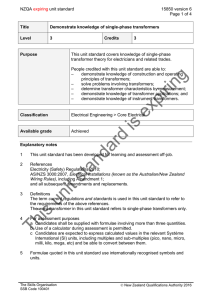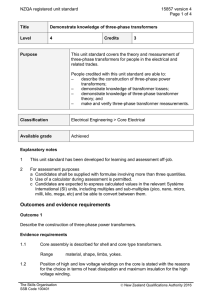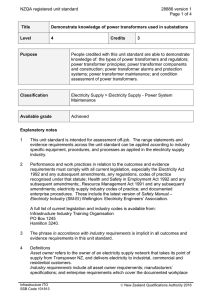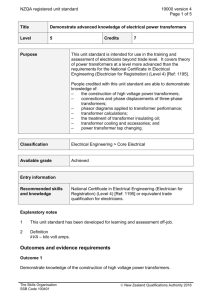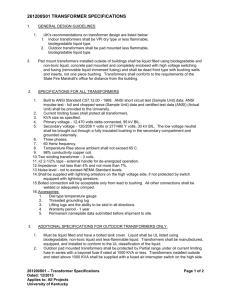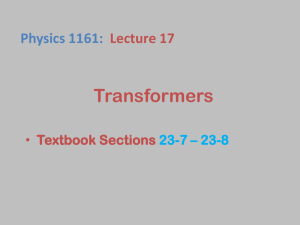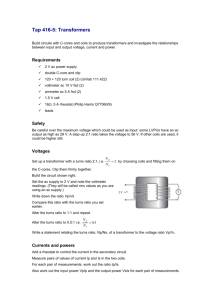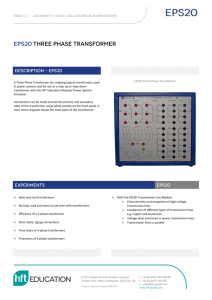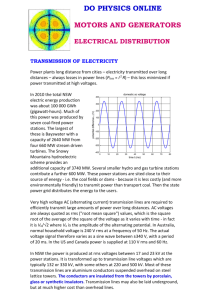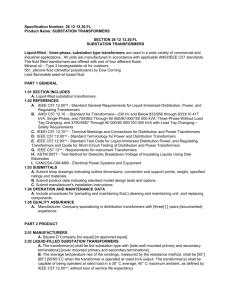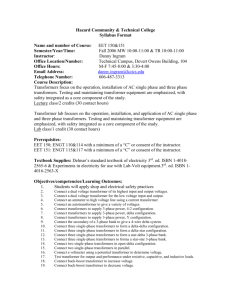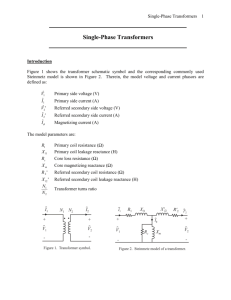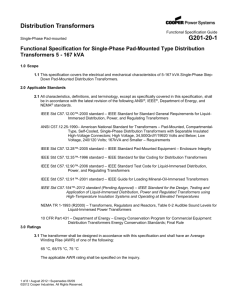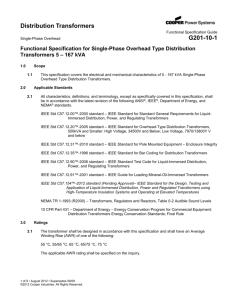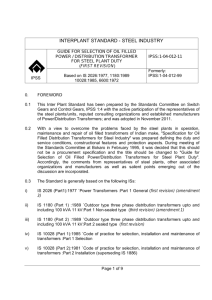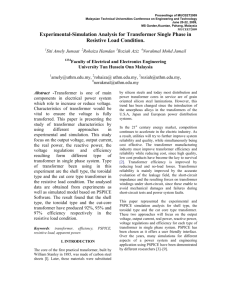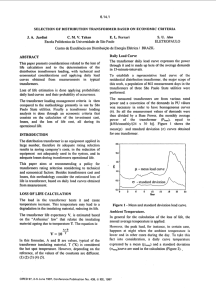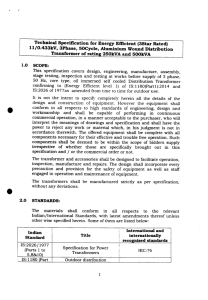15850 Demonstrate knowledge of single-phase transformers
advertisement
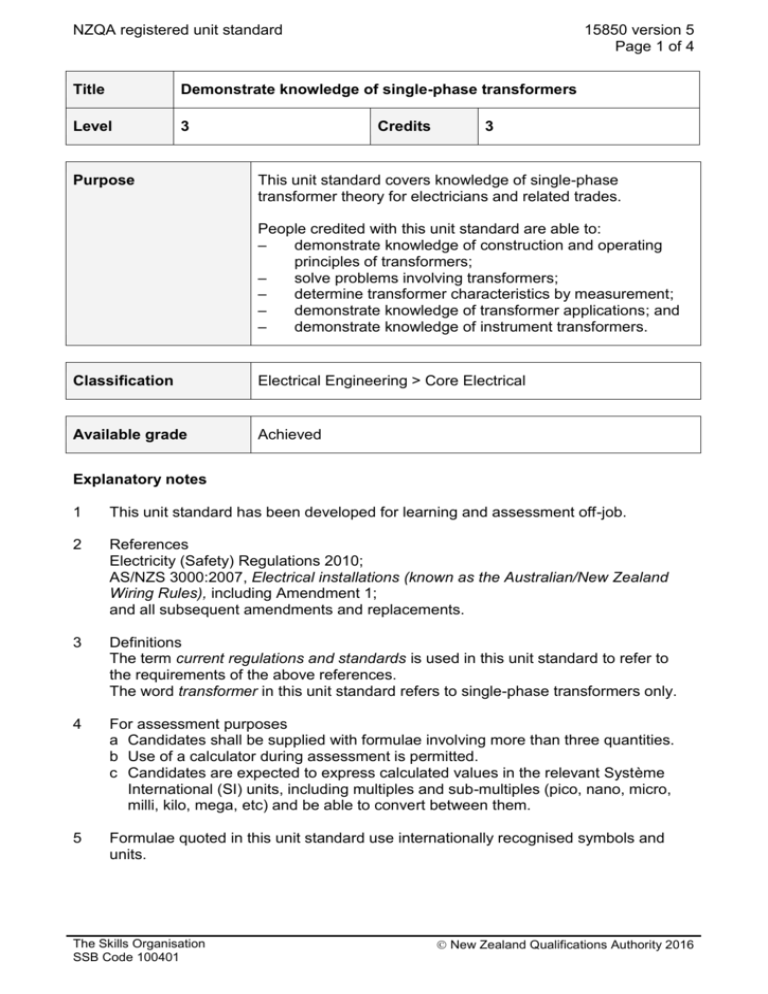
NZQA registered unit standard 15850 version 5 Page 1 of 4 Title Demonstrate knowledge of single-phase transformers Level 3 Purpose Credits 3 This unit standard covers knowledge of single-phase transformer theory for electricians and related trades. People credited with this unit standard are able to: – demonstrate knowledge of construction and operating principles of transformers; – solve problems involving transformers; – determine transformer characteristics by measurement; – demonstrate knowledge of transformer applications; and – demonstrate knowledge of instrument transformers. Classification Electrical Engineering > Core Electrical Available grade Achieved Explanatory notes 1 This unit standard has been developed for learning and assessment off-job. 2 References Electricity (Safety) Regulations 2010; AS/NZS 3000:2007, Electrical installations (known as the Australian/New Zealand Wiring Rules), including Amendment 1; and all subsequent amendments and replacements. 3 Definitions The term current regulations and standards is used in this unit standard to refer to the requirements of the above references. The word transformer in this unit standard refers to single-phase transformers only. 4 For assessment purposes a Candidates shall be supplied with formulae involving more than three quantities. b Use of a calculator during assessment is permitted. c Candidates are expected to express calculated values in the relevant Système International (SI) units, including multiples and sub-multiples (pico, nano, micro, milli, kilo, mega, etc) and be able to convert between them. 5 Formulae quoted in this unit standard use internationally recognised symbols and units. The Skills Organisation SSB Code 100401 New Zealand Qualifications Authority 2016 NZQA registered unit standard 15850 version 5 Page 2 of 4 Outcomes and evidence requirements Outcome 1 Demonstrate knowledge of construction and operating principles of transformers. Range double-wound transformer, auto-transformer. Evidence requirements 1.1 Transformer construction is described with the aid of a sketch and with reference to cores and windings. 1.2 Operating principle is described with reference to mutual or self-induction and to regulation by tap changing. Outcome 2 Solve problems involving transformers. Evidence requirements 2.1 Problems involving primary and secondary turns, voltage, and current are solved for resistive loads. Range IP/IS = NS/NP = VS/VP. 2.2 Simple problems involving transformer ratings are solved for resistive loads and negligible losses. 2.3 The difference between volt-amps and watts is explained with reference to reactive and resistive loads. Outcome 3 Determine transformer characteristics by measurement. Range isolating transformer, step-down double-wound transformer, auto-transformer. Evidence requirements 3.1 Voltages across and currents through a resistive load connected to each type of transformer are measured and recorded. 3.2 Volt-amps, power in load, and turns ratio are calculated. 3.3 Variations between measured and nameplate values are explained in terms of supply variations, transformer losses, and measurement error. The Skills Organisation SSB Code 100401 New Zealand Qualifications Authority 2016 NZQA registered unit standard 15850 version 5 Page 3 of 4 Outcome 4 Demonstrate knowledge of transformer applications. Evidence requirements 4.1 Double-wound and auto-transformers are compared. Range 4.2 Common transformer applications are stated. Range 4.3 physical size, cost and complexity for similar volt-amp, operating voltage ranges, response to load changes (regulation), ambient temperature, ease of cooling, operational requirements. double-wound transformer – step up and step down of voltage and current, safety isolation, safety extra-low-voltage source, instrumentation; auto-transformer – reduced-voltage motor starters, voltage regulation, variable-voltage supplies. Requirements of current regulations and standards with respect to transformers are stated. Range extra-low voltage circuits, electric toys, medical and dental apparatus, high-voltage discharge lamps, restrictions for autotransformers; for assessment purposes candidates may refer to current regulations and standards. Outcome 5 Demonstrate knowledge of instrument transformers. Evidence requirements 5.1 Voltage transformers are described with reference to typical connections, standard voltage ranges, and burden. 5.2 Current transformers are described in terms of principle of operation, typical connections, standard current ranges, burden, and safety precautions. Range 5.3 current transformer types – bar, wound primary, measurement and protection types. Reasons for using instrument transformers are described in terms of measurement convenience, and personal and property safety. Range The Skills Organisation SSB Code 100401 isolation, reduction of voltage and current, remote measurement, metering, indication. New Zealand Qualifications Authority 2016 NZQA registered unit standard 15850 version 5 Page 4 of 4 Replacement information This unit standard replaced unit standard 1203. Planned review date 31 December 2014 Status information and last date for assessment for superseded versions Process Version Date Last Date for Assessment Registration 1 10 February 1999 31 December 2013 Revision 2 3 April 2001 31 December 2013 Review 3 26 May 2005 N/A Rollover and Revision 4 15 March 2012 N/A Revision 5 15 January 2014 N/A Consent and Moderation Requirements (CMR) reference 0003 This CMR can be accessed at http://www.nzqa.govt.nz/framework/search/index.do. Please note Providers must be granted consent to assess against standards (accredited) by NZQA, before they can report credits from assessment against unit standards or deliver courses of study leading to that assessment. Industry Training Organisations must be granted consent to assess against standards by NZQA before they can register credits from assessment against unit standards. Providers and Industry Training Organisations, which have been granted consent and which are assessing against unit standards must engage with the moderation system that applies to those standards. Requirements for consent to assess and an outline of the moderation system that applies to this standard are outlined in the Consent and Moderation Requirements (CMR). The CMR also includes useful information about special requirements for organisations wishing to develop education and training programmes, such as minimum qualifications for tutors and assessors, and special resource requirements. Comments on this unit standard Please contact The Skills Organisation reviewcomments@skills.org.nz if you wish to suggest changes to the content of this unit standard. The Skills Organisation SSB Code 100401 New Zealand Qualifications Authority 2016
